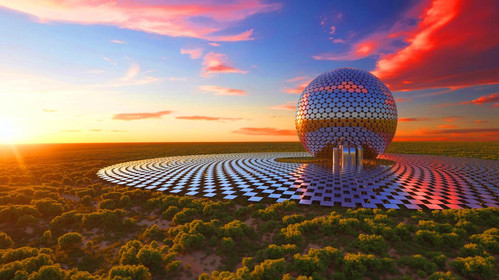Environment & Energy
Related: About this forum"Hydrogen Just Got Cheaper Than Ever": New Solar Reactor Breakthrough Crushes Electrolysis Costs, Redefines Clean Energy

Illustration of a solar-powered reactor producing green hydrogen. Image generated by AI
“Hydrogen Just Got Cheaper Than Ever”: New Solar Reactor Breakthrough Crushes Electrolysis Costs and Redefines Clean Energy Production
Sustainability-Times.com | Noah Bennett | June 26, 2025
Australia's national science agency, CSIRO, has unveiled a revolutionary solar reactor capable of producing green hydrogen more efficiently and affordably than traditional electrolysis, marking a significant milestone in the pursuit of sustainable energy solutions.
In an era where the quest for sustainable energy solutions is more critical than ever, a groundbreaking development in solar technology offers new hope. The Commonwealth Scientific and Industrial Research Organisation (CSIRO) in Australia has unveiled a pioneering solar-powered reactor capable of producing green hydrogen. This innovation promises to revolutionize the clean energy landscape, particularly for industries challenging to electrify directly. As we delve into this transformative technology, we explore its potential to reshape energy production and its broader implications for the future.
Sunlight Fuels Hydrogen
Australia, a country basking in sunlight, relies heavily on fuel-based energy sources, especially in sectors like heavy industry and transportation. Despite the widespread use of solar panels, approximately 75 percent of the nation’s energy still comes from conventional fuels. This reality poses a challenge for achieving low-carbon energy solutions. One of the most promising alternatives is green hydrogen, a low-emission fuel perfect for sectors where electrification is not feasible. However, the traditional method of producing green hydrogen, known as electrolysis, is energy-intensive and costly.
To address these challenges, CSIRO has embarked on a mission to develop more efficient and scalable hydrogen production methods. At the heart of this innovation is the use of concentrated solar energy and specially designed heliostats. These heliostats track the sun and reflect its light onto a central tower, which then directs the sunlight downwards onto a solar reactor. This method not only enhances efficiency but also represents a significant departure from traditional solar thermal systems, where sunlight is concentrated at the top of the tower...more
https://www.sustainability-times.com/energy/hydrogen-just-got-cheaper-than-ever-new-solar-reactor-breakthrough-crushes-electrolysis-costs-and-redefines-clean-energy-production/
H2 bashing Buffoons like Liebrich and Barnard

claim to know exactly what energy will cost in as much as 80 years, which is laughable, absurd and ridiculous. Solar bashing buffoons from 15 yrs ago thought they knew the future too. Then came China.
Technology Explainer Video Example | CSIRO Hydrogen | Explanimate!
Does this mean we can stop burning coal to power the Tesla and Prius and Rivians
hildegaard28
(568 posts)Can’t wait for Republicans to try to outlaw it. No woke sustainable energy allowed in this country. Sustainability is for communists. Real capitals burn through their resources until there’s a crisis, then deny the crisis.
caraher
(6,332 posts)The main article ends by telling us, "Our author used artificial intelligence to enhance this article." The headline quote about hydrogen getting cheaper than ever is not sourced anywhere in the ghostwritten/plagiarized-by-AI piece carrying Noah Bennett's byline (Noah seems to be a veritable factory of AI co-authored hype articles.)
It looks like this may be an interesting small-scale proof-of-concept project, but it doesn't build credibility when the post opens with an AI image (why the hell would there be a spherical array of mirrors on the central tower?!) and the main article is a manifestly low-quality source. I had a weirdly hard time (given that this is a legitimate Australian government research institution) finding scholarly literature on this project beyond some theory articles related to the design of the system.
CSIRO's own article is a much better, though not entirely satisfactory. I would have expected to find links to peer reviewed articles or preprints in the CSIRO pages for the main investigators, but what we have at this stage is basically a data-free press release.
What they say about efficiency makes the project seem like a poor use of the solar resource. The PI states, “We’re not yet at industrial scale, but we’ve demonstrated strong reactivity under relatively moderate conditions, and with further refinement, it could match electrolysis in both performance and cost.”
Above that quote, the CSIRO piece says, "The project proved the full thermochemical hydrogen production cycle – from solar input to hydrogen output, which has a potential to achieve a solar-to-hydrogen efficiency of higher than 20 per cent. That’s higher than many existing systems, which typically operate around 15 per cent."
They don't state their actual efficiency, but what I'd take to be an upper limit on the efficiency of the process. Given that you're going to the trouble of building a concentrating solar power system, I don't see why one wouldn't generate electricity instead with a heat engine that could easily exceed 40% efficiency. But in fact, it looks like the real use case they have in mind isn't green hydrogen but the use of Australian solar energy to produce methanol for export to Japan.
The project has three programs that cover different aspects of the technology, demonstration of the complete water splitting process under a new solar thermal beam down concept, development of new catalyst materials to improve performance and a techno-economic feasibility study of a methanol pathway for export of hydrogen.
What they mainly did was the build a nice testbed for the study of chemical processes driven by concentrated solar energy.
NNadir
(36,112 posts)...that it is no different than the last 50 years of fossil fuel greenwashing marketing crap.
I therefore didn't pick up just how lazily rote and mass produced this these ads are.
There are, i would guess, thousands of solar-to-hydrogen papers published each year most of which are not worth reading, but I do keep in my files some of them, the thermochemical cycle types since they can me interesting if one is agnostic about the source of primary energy. I suspect that many solar thermochemical papers are written by people who understand the economic and environmental unsuitability of solar heat schemes, but chose the heat source to be solar to improve their odds of their grant application being accepted.
NNadir
(36,112 posts)...handed out by fossil fuel interests has not, is not, and will not change reality.
Of course the picture of the clown may be the only thing accurate in this post, since hydrogen clowns are neither serious, scientifically literate, or possessed with an ethical basis.
The continuous run of ads here trying to greenwash fossil fuels by rebranding them as "green hydrogen" will be no more effective than the last half a century of similar criminally stupid advertising. The reason is that the laws of physics are not subject to change by marketing.